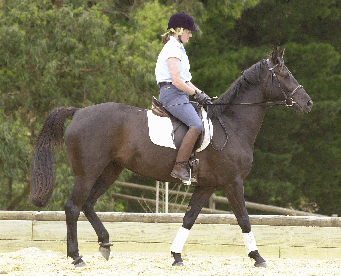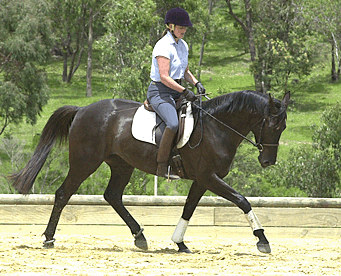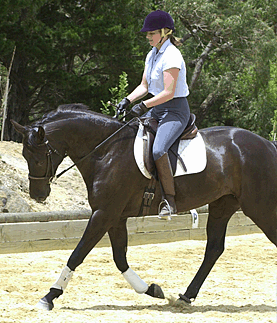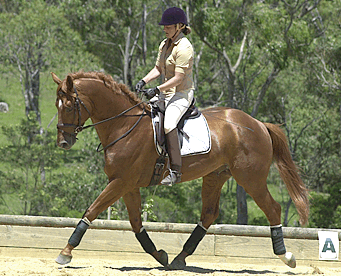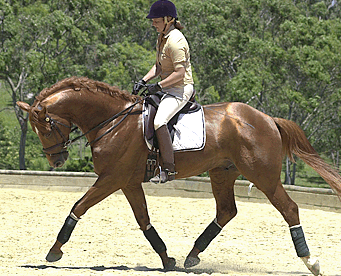When Martina first visited Australia back in 2001, she and her husband, Jorn, became first friends not just with Jim and Emmie Schmul but also with the riders who enjoyed her full-on enthusiasm in their riding sessions.
This visit Martina caught up with two old friends– Monica Bird and her cute little mare, Argentille Gabriella. On her last trip, and Martina found Monica and her mare, willing, enthusiastic and talented pupils – with just one problem, every time the mare goes to do a flying change, she is late behind.
So here they are, giving it one last try – the mare may not realise it but her options are to get quicker behind, or motherhood!
And at the end of the day, it seems like a career as a brood mare beckons…
“Some horses just don’t get flying changes. Not all of us become professors; some of us have to teach riding. So there are just some things you can’t teach horses – some won’t do piaffe, some won’t do flying changes…”
“Yes. Actually when they learn it in the wrong way it is worse. The rider was really trying every way to get a change and it was still not right. Maybe with another two years in a professional stable, maybe she would be right – maybe, but not for sure. It’s a little bit sad because it is a super super horse, and the canter is good enough to get it.”
“I was happy with the trot work at the end, and the pirouette work, Monica felt the difference. I get the feeling when she is riding by herself that she is not active enough, she is trying really hard to do the home work from the clinic two years ago, and the horse is getting much much better in this, but for the flying change she would need help every second day, to make the horse more and more through.”
“I rode her the last time I was in Australia, and I couldn’t get the change. This time she looks better and more through in her canter but the problem is in her mind.”
“Oh Monica who will you breed the mare to?”
“I have some semen from Don Schufro.”
“Let’s leave the changes until later. We’ll do some pirouette – on a circle in travers, make the circle smaller, smaller, then go out. RHYTHM, RHYTHM, RHYTHM! Just get a few half strides, then out, then back.”
“Keep her in front of the inside leg, on the outside rein half halt. You just have to ride, not sit and wait – no-one is coming to help you!”
And there the pirouette comes beautifully, and the session is ended, and Monica still wondering how far her mare could have gone if only she could do the changes!
The next customers are Sam Hodges and the just started three year old, Felicity. Martina keeps it ever so simple for the babies…
“Just nice simple work. Trot, walk, canter, both sides, circle, and the whole arena. To give them the security that they can trust your hands and they can follow your hands.”
And here, Martina who is a stickler for rider correctness, has identified a problem:
“The rider is coming a little bit too much backwards with the hands and she was changing the reins in very short ways, and so couldn’t really get her correct in front. It was that the horse didn’t understand – the leg is pushing and oh, the rein is coming, so the horse can’t understand what to do. So we changed the way she rode her, she changed reins – and went slower and bigger. Otherwise you are pushing her forward then you come on the rein to make a small serpentine or something, and that is not very helpful.”
“The other thing we found was that the horse was having it easy on the right hand, so we tried to get her more round and in front of the rider’s legs on the right hand, then we went to the left rein and tried to work her a little bit in front and worked on the left side so long as she was round and they weren’t getting into a fight. Then change again to the right, make both of them comfortable and then change again. At least that way she will learn that both sides work the same way.”
“We should remember that this horse has only been ridden ten times and so we should be happy with the work she is doing.”
“When you start with young horses, the most important thing is that they go forward – but every horse goes forward in his own rhythm. That’s the biggest problem, if the horse is not listening to your leg and going forward, then they start to back off, coming too much backwards on your legs, and if you let that keep happening, then there is an explosion, and you get bucked off or the horse goes up in front. So the first natural thing is for the horse to learn to go forward with the rider. It doesn’t matter if they go in canter or disunited, at least forward. It’s best if they stay round because then at least they don’t hurt themselves in the back.”
“When Boyd Martin was breaking in a few horses at my place, he just let them go forward, and didn’t help them to balance, he let them work it out themselves. He stayed away from the wall. The only thing we taught him was to keep them a little bit more round and over the back.”
So the lady riders who are scared to send their horses forward in case they buck, should just send for Boyd?
“Often the riders are scared that the horse will buck them off, but the problem is that if they don’t really get the horse going forward when it is young, and they ride it for a few more years, then they really get bucked off because the horses are stronger, and when they know this, then you have something really hard to fix. Better to get Boyd in the first place… or there must be a few other young guys in Australia who can ride like him!”
“With a young horse like this, it is as if you are doing something you are not used to doing – suppose I ride a bike for three hours, then I’ll feel my muscles the next day, and the horse is the same – he just can’t tell us. To build up the muscles we must keep on going with the work, but maybe with a lunging day, or lunge the horse before the working session without the rider, just to get the horse going forward. That can help a lot, send them forward on the lunge line so that they have the power to open up, and go forward under saddle. Some of the horses are not just tense on the leg; they are already tense on the girth. You can see it when a horse without a saddle or a girth is trotting much nicer, then you put the girth on, and maybe it still trots, but then comes the saddle, and you can see the difference – and then you add the weight of the rider as well and you have lost the movement.”
You were talking about setting up to go across the diagonal, that the horse had to be on both reins, both hands turning, hind feet into front feet?
“What I noticed was that on the diagonal, the horse was actually doing serpentines. The neck was bent to one side and the hindlegs to the other; we must still work on having the horse straight and in front of our legs, so we give them security with both reins and both legs. What some of the riders like to do is pull on the inside rein coming out of the corner, instead of giving the horse the security to turn with both reins, that’s what I tried to explain. She has to work a bit more on the short side to get the horse in front of her leg, especially on the left rein.”
The next day Sam came with another young horse, but one that has had over a year’s riding, and considerable success in young horse classes – Weltwunder E (Felicity’s three-quarter brother aka Champ) but Martina’s message was much the same.
Ride the horse forward – but on your terms! Champ had decided that he was free to yank the reins out of Sam’s hands:
“If he is rude to you, you be rude back to him. He must listen to you – he’s old enough now.”
But even ‘being rude’ involves keeping the correct position:
“Why do Australian hands go up all the time?”
Some wit on the sidelines points out that Sam studied under Heath Ryan – perhaps that’s a cause?
“I told Heath too – he must keep his hands down. In every book it says the same thing, keep your hands down but don’t let him hang on the reins – if he’s hanging, and you are hanging, he just gets stronger. More half halts. If he is a good boy, tell him – if he’s bad, tell him. But we don’t have to make them tired of what we are doing. We have to make it interesting for them, we should be flexible in the exercises we do.”
You must learn to have the horse more on your seat and less on the reins.”
And so it went, always bouncing between the two vital factors – how the horse was going, how the rider was sitting, and the way in which, one influenced the other.
With Sam there was the additional element of riding a stallion – is it more difficult for women to ride stallions?
“You really have to be strong in what you are doing, you must know when you are doing the right thing – it’s like educating a child, you must find a way they like to do it. With stallions it is always a bit more difficult because they have their own ideas and you always have to discuss it a few times with them, but they have to listen to you – especially if they are outside and there is another horse in the paddock, or they are at a competition. It is always a little bit more difficult to work with stallions, easier with a gelding or a mare.”
“My stallion, Ratino likes to show off a lot, and I don’t like that so much, it is better nowadays in that when we come into a warmup arena, he is quiet and listening to me. Young stallions often get so excited in the warmup that they don’t have any energy left when they come inside the competition arena.”
“Rubinstein was not like that. He was so quiet and so well behaved. I think it was also that he was breeding from the beginning, so he was tired of mares! But I would not try that with Ratino – he can try breeding later.”
And at the end of her Australian lessons, it was back to Europe, and back to the Grand Prix classes with the young stallion, Ratino and the rest of her large barn of dressage horses. We are fortunate indeed that Martina and her husband Jorn have developed a taste for the Australian sunshine… hopefully they will be back before too long!


